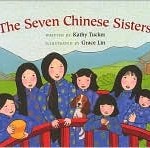
The Seven Chinese Sisters
Written by Kathy Tucker
Illustrated by Grace Lin
Albert Whitman, 2003, ISBN: 9-780-80757-310-5
In this retelling of an ancient Chinese folktale, seven Chinese sisters with “shining black hair and sparkling eyes” live together, each possessing with their own unique skill. First Sister rides a scooter as fast as the wind, Second Sister knows karate, Third Sister counts beyond 500, Fourth Sister talks to dogs, Fifth Sister catches any ball, and Sixth Sister cooks delicious noodle soup. Seventh Sister, the baby, hasn’t spoken or discovered her ability yet. One day a terrible hungry dragon on a faraway mountain wakes up to the smell of Sixth Sister’s noodle soup and flies to their house. When he sees Seventh Sister in the kitchen, he forgets about the soup, snatches her, and takes her to his cave. As soon as he sets her down, Seventh Sister yells her first word, “HELP!” The other sisters take off to rescue Seventh Sister, each using their skill to make their mission successful. Once Seventh Sister is safe, the Sisters take compassion on the starving dragon and promise to bring him soup the next day.
The Seven Chinese Sisters is an action-filled story with strong female characters who demonstrate courage and resourcefulness as they work together using their talents to rescue their sister. Each sister is portrayed with her own unique features and personality, unlike the stereotyped characters in books like The Five Chinese Brothers (Claire Huchet Bishop & Kurt Wiese, 1938). Lin’s illustrations are brightly colored paintings that convey the action and emotions in the story. Her use of patterns such as in the clothing and background, add to the richness of the illustrations.
Author Kathy Tucker is from the state of Washington and illustrator Grace Lin is Chinese-American and from New York. While Tucker wrote the book to encourage girls to develop their talents and with Lin produced a book with many strengths, numerous aspects of the written text and illustrations are not authentic to Chinese culture, as the following examples demonstrate.
- Dragons in Chinese culture are magnificent and royal, representing good luck and prosperity which contrasts sharply with the weak, anemic-looking dragon.
- Structural features of the house are not authentic to Chinese culture. Chinese houses do not have pillars next to the doors nor windows above doors.
- Also, the windows in traditional Chinese houses are made of bricks or wood and are open, without glass; the windows in the illustrations are common in American homes.
- The Chinese eat at round tables. The rectangular table in the illustration of the kitchen is more like an American dining table.
- The Seven Sisters all wear cheongsam but authentic Chinese cheongsam is a close-fitting dress with low side vents and worn without trousers, not loose-fitting dresses with high vents and trousers.
- Chinese cheongsam is also worn with embroidered shoes, not the Kong-Fu shoes shown in the illustrations.
- Other features not authentic to Chinese culture include Seventh Sister’s pacifier, drinking cup, and high chair; oven mitts and the electric stove; and, karate, which is native to Japan.
- An additional issue with the story is that it begins “Once upon a time”– setting it in the long ago past, yet things like the scooter are contemporary.
Reading The Seven Chinese Sisters in a text set with books that are more authentic to Chinese culture, students could be encouraged to think critically about issues of authenticity. Such a text set of folktales might include:
Lon Po Po: A Red-Riding Hood Story from China
- (Ed Young, 1996)
The Lost Horse: A Chinese Folktale
- (Ed Young, 2004)
Yeh-Shen: A Cinderella Story from China
- (Ai Lin Louie, 1996).
In a text set on dragons, books that would help students explore dragons and their role in the Chinese culture include:
Legend of the Chinese Dragon
- (Marie Sellier, 2008)
Jin Jin the Dragon
- (Grace Chang, 2008)
The Dragon’s Tale and Other Animal Fables of the Chinese Zodiac
- (Demi, 1996)
Prisca Martens, Towson University, Towson, MD
Wen-Yun Lin, National Taipei University of Education, Taiwan
WOW Review, Volume I, Issue 3 by Worlds of Words is licensed under a Creative Commons Attribution-NonCommercial-ShareAlike 4.0 International License. Based on work at https://wowlit.org/on-line-publications/review/i-3/

One thought on “WOW Review Volume I Issue 3”
Comments are closed.